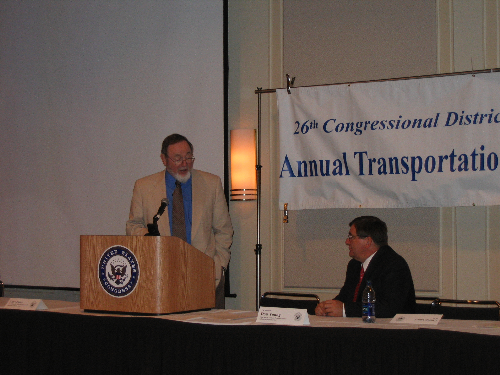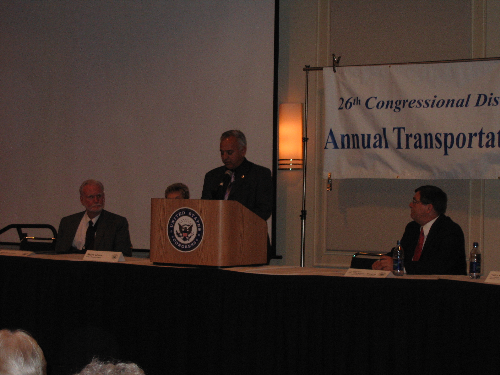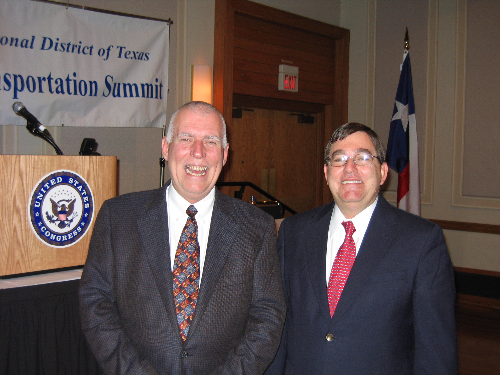Transportation Summit Brings Leaders and Visionaries Together on Roads, Transit
Denton, Texas,
December 1, 2005
|
Michelle Stein
((202) 225-7772)
Yesterday, Congressman Michael C. Burgess (TX-26), in conjunction with the Texas Department of Transportation, hosted the 3rd Annual 26th Congressional District Transportation Summit. The event highlighted local, state and federal transportation experts and was devoted to discussing and improving transportation throughout North Texas.
“Improving transportation requires a fundamentally change in the philosophy of how we fund projects, stated Congressman Michael Burgess. “ It is clear that there is a need for flexibility in funding transportation projects,” continued Rep. Burgess. “Together, we can use our limited transportation dollars in a more sensible, smarter fashion, and complete projects in a faster, more efficient manner.”
The event’s opening remarks were given by Congressman Michael Burgess and Ric Williamson, Chairman of the Texas Transportation Commission.
Praise was given to the success of Congressman Burgess and House Transportation and Infrastructure Committee Chairman Don Young (R-AL) for enacting, in August of this year, the Highway Reauthorization bill, commonly referred to as TEA-LU. This legislation reauthorized appropriations from the Highway Trust Fund for highway programs, research and technology, motor carrier transportation and safety, and transportation research and education. It designated $286.4 billion to be distributed over the six-year life of the legislation among highway, transit and safety projects throughout the country.
TEA-LU had several key policy revisions for Texas:
Toll-Credits
During the initial House passage of this legislation in March, Congressman Michael Burgess offered an amendment that would allow states to receive transportation development credits, better known as “toll credits.” This provision was included in the final version of TEA-LU. Now, states will receive transportation development credits in a timely manner. States will be able to reinvest in their transportation systems without continually requesting additional federal monies to meet their needs.
“It is imperative that Congress continue to focus on bringing innovative financing tools and more streamlined processes to meet transportation infrastructure needs,” commented Congressman Michael Burgess.
Design-Build
In March, Congressman Burgess reintroduced language on the concept of “Design-Build” for the 109th Congress. “Design-Build” is a term to describe an innovative project delivery method that combines the design and construction of a road project into one contract rather than the traditional “Design-Bid-Build” method of having individual contracts for separate, sequential phases of a project. By modifying the existing law, “Design-Build” gives Texas and other states additional flexibility to design and build roads concurrently, not sequentially. By integrating the design-build portion of a project, states can complete projects in a more efficient and inexpensive manner.
“This philosophy of road building would bring relief to dangerous and congested roads that can not wait another 20 years to get fixed,” Congressman Michael Burgess.
Congressman Burgess’ work on design-build earned him the Design-Build Institute of America’s Distinguished Legislator Leadership Award. Dan Stoppenhagen, Director of Transportation and Infrastructure for Fluor Enterprise, Inc. presented the award during the summit.
Rate-of-Return
The last key provision from the transportation reauthorization bill concerns rate-of-return for federal transportation dollars. Currently, for every $1 Texans send to Federal Highway Administration, they receive only 88 cents back. This bill will allow for a gradual increase in the national rate of return from 90.5 percent in 2005 to 92.0 percent in 2009.
“This is an important victory for the State of Texas as we continue to work on ways to pay for our growing transportation needs for the 21st century,” remarked Congressman Burgess. “The next highway reauthorization bill will begin taking shape soon in Washington, and I encourage all local transportation leaders to discuss their thoughts and ideas with me.”
Event Details
Ric Williamson’s remarks covered the need for more flexibility regarding how we spend and receive transportation dollars noting that in the last 25 years, the population of Texas increased 57% and will increase another 60% in the next 25 years.
Michael Morris, Transportation Director, North Central Texas Council of Governments remarked that the annual cost of congestion will be $11.8 billion in the year 2025, and that the vision of transportation must include more than just building new roads.
There were then three panels within the event. First, there were presentations by county representatives including Mary Horn, Judge, Denton County; Oscar Trevino, Mayor, North Richland Hills (Tarrant County); and Bill Freeman, Judge, Cooke County. There remarks were broader in their approach encompassing several facets of transportation within their communities. Dedicated to their respective counties, each discussing the larger projects they believe should be improved which included Highway 121, Interstate 35 East and West, Highway 820 and Farm to Market Road 51.
The second panel focused on highway infrastructure and highlighted Bill Hale, Dallas District, Texas Department of Transportation; Maribel Chavez, Fort Worth District, Texas Department of Transportation; and Larry Tegtmeyer, Wichita Falls District, Texas Department of Transportation.
Focusing on the mobility needs of DFW, Bill Hale discussed how TXDoT’s financing tools will allow Texas to build roads in less time. These financial tools include toll, public/private, pass-through toll and managed lanes.
Maribel Chavez switched gears to discuss Tarrant County plans to improve highways over the next four years with $2 billion in state and federal funds. In her remarks she underscored the need for environmental streamlining for transportation projects.
Larry Tegtmeyer commented on the need to maintain the current system and improve safety. Cooke County, which lies on the fringe of the ever-increasing metroplex, is looking for more flexibility in project delivery. Mr. Tegtmeyer also cited the need to give Interstate 35 additional lanes through Cooke County, an overpass for Highway 82 and the need for a loop around the city of Gainesville.
The final panel focused on North Texas’ transit infrastructure and highlight Doug Allen, Dallas Area Rapid Transit (DART); Charles Emery, Denton County Transportation Authority; and Dick Ruddell, Fort Worth “T.”
Doug Allen opened the panel commenting that DART is the largest light-rail in the southwest and transports over 1 million passengers every week. DART's northwest/southeast corridor light-rail project runs to Carrolton and will connect with the Denton County Transportation Authority (DCTA).
This provided a seamless transition into Charles Emery’s remarks. He provided a brief history and evolution of the DCTA and discussed the locally preferred alternative for Denton – Highland Village – Lewisville – Carrollton corridor. The locally preferred alternative constitutes utilizing the former MKT railroad line, which runs parallel to Interstate 35E to the East. Centrally located, the system would support riders from downtown Denton, Texas Woman’s University and the University of North Texas, in addition to riders from the Lewisville-Highland Village area.
Dick Ruddell closed the final panel discussing the projected congestion levels for 2025. He too sounded the call for flexibility in spending transportation dollars and seeks a more seamless regional transit system.
In all, the 3rd Annual Transportation Summit included over 80 transportation officials. The summit provided a chance for these leaders to discuss innovative financing concepts and to set a strategy for improving North Texas’ transportation future.
|
Latest from twitter
Get the most up to date news from me on Twitter.





